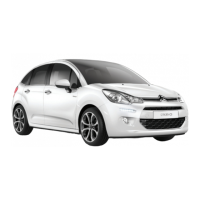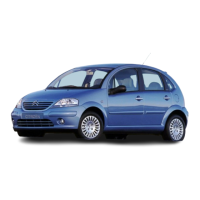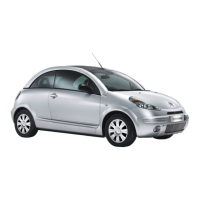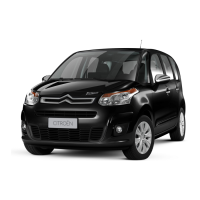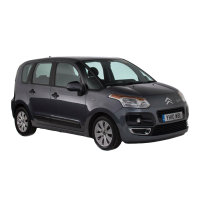58
Lighting and visibility
The state of the system stays in the memory
when switching o the ignition.
Operation
If the ambient light level is very low and trac
conditions permit:
– The main beam headlamps
come on automatically. These
indicator lamps light up on the instrument panel.
If the ambient light level is sucient and/or the
trac conditions do not allow the main beam
headlamps to be lit:
– The dipped beam headlamps
remain lit. These indicator lamps
light up on the instrument panel.
The function is deactivated if the foglamps
are switched on or if the system detects poor
visibility conditions (e.g. fog, heavy rain,
snowfall).
When the foglamps are switched o or when the
visibility conditions become favourable again, the
function is automatically reactivated.
This indicator lamp goes out when the
function is deactivated.
Pause
If the situation requires a change of headlamp
beam, the driver can take over at any time.
► Switch the headlamps manually between
dipped and main beam to pause the function.
If the "AUTO" and "Dipped beam" indicator
lamps were on, the system changes to main
beam.
► With the ignition o, pull the lighting control
stalk toward you ("headlamp ash") to activate/
deactivate the function.
Manual guide-me-home lighting goes o
automatically after a period of time.
Welcome lighting
With the "Automatic headlamp illumination"
function activated, in poor light, the sidelamps
and dipped beam headlamps come on
automatically when the vehicle is unlocked.
Activation, deactivation and the duration of the
exterior welcome lighting are set in the vehicle
conguration menu.
Automatic lighting
systems - General
recommendations
The automatic lighting systems use a detection
camera, located at the top of the windscreen.
Operating limits
The system may be disrupted or not work
correctly:
– When visibility conditions are poor
(e.g. snowfall, heavy rain).
– If the windscreen is dirty, misted-up or
masked (e.g. sticker) in front of the camera.
– If the vehicle is facing highly reective signs
or safety barrier reectors.
The system is not able to detect:
– Road users that do not have their own
lighting, such as pedestrians.
– Vehicles with hidden lighting (e.g. travelling
behind a safety barrier on the motorway).
– Vehicles at the top or bottom of a steep
slope, on winding roads, on crossroads.
Maintenance
Clean the windscreen regularly,
particularly the area in front of the camera.
The internal surface of the windscreen can
also become misted around the camera.
In humid and cold weather, demist the
windscreen regularly.
Do not allow snow to accumulate on the
bonnet or roof of the vehicle as this could
obstruct the camera.
Automatic headlamp
dipping
For more information, refer to the
General recommendations for
automatic lighting systems.
With the ring of the lighting control stalk in the
"AUTO" position and the function activated on
the touch screen, this system automatically
switches between dipped and main beam
headlamps, according to lighting and trac
conditions, using a camera located at the top of
the windscreen.
This system is a driving aid.
The driver remains responsible for
the vehicle's lighting, its correct use in the
prevailing light, visibility and trac conditions,
and for compliance with driving and vehicle
regulations.
The system becomes operational when
the vehicle exceeds 16 mph (25 km/h).
When the speed falls below 9 mph (15 km/h),
the function is no longer operational.
Activation/Deactivation
It is set via the Driving / Vehicle touch
screen menu.
When deactivated, the lighting system changes
to "automatic illumination of headlamps" mode.

